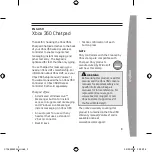
Last update: 2021/12/17 00:00
d2:laser_controller https://www.vescent.com/manuals/doku.php?id=d2:laser_controller
https://www.vescent.com/manuals/
Printed on 2021/12/18 07:41
no current is flowing through the laser diode. However, the Current Monitor will read up to 30 mA of
current flowing through the short. This is normal. When the switch is in the “ON” position, the current
monitor accurately measures the current flowing through the laser diode.
The BNC monitor outputs a voltage corresponding to the monitor selection. When monitoring Current
or Current limit, the output is 1V = 1 A and will include the current modulation/servo signal from the
Servo Input connector. When monitoring a Temperature Setpoint, the output is 1mV = 1°C. When
monitoring a Temperature Error, the output is 1V = 1°C.
Current Control
Current Lim (LED)
The current limit indicator lights when the current limit circuit is activated. If the user attempts to set
the current over the current limit setpoint the circuit shunts the excess current through a transistor to
ground
Fine Current (knob)
The fine current adjusts the diode injection current by ½-1 % of the coarse control setting. Use this
control for fine positioning of the laser frequency prior to locking.
Course Current (Scale Dial)
The course current control sets the laser diode injection current between 0 and 200 mA (0 and 500
mA for 500 mA version). To set the current, switch the selector knob in the monitor section so that the
current LED (I) is lit. Then adjust the course current to the desired setting.
Current Limit Set (Trimpot)
The current limit set is a front panel trimpot adjustment. Set the selector knob to the I
lim
position and
adjust the trimpot to the desired value. The Current Limit should be set below the maximum current
for the laser diode.
RF Input (BNC)
The RF input is ac coupled to the laser diode through a 10 nF capacitor. Over ~3 MHz the impedance
of this input will approach the ac impedance of the laser diode of ~5 Ω. This input is normally
connected to the RF output from the Laser Servo module, which applies FM sidebands at 4 MHz to the
laser output.
Note: a large voltage transient to this input could possibly cause damage to the laser diode. If you are
connecting other equipment to this input do not exceed 0.25 Vrms from a 50 Ω source or 1 mW of
power.
Current Servo Input (BNC)
The current servo input adds or subtracts current though 1 k Ω connected to the laser diode giving a
modulation coefficient of 1 mA/V. A bias circuit sets the voltage of the current servo input to zero
volts. (Normally, a connection to the laser diode would place this voltage at ~ 2V or equal to the
forward diode drop.) Therefore, leaving the input open or grounded does not alter the current to the
laser diode.





































